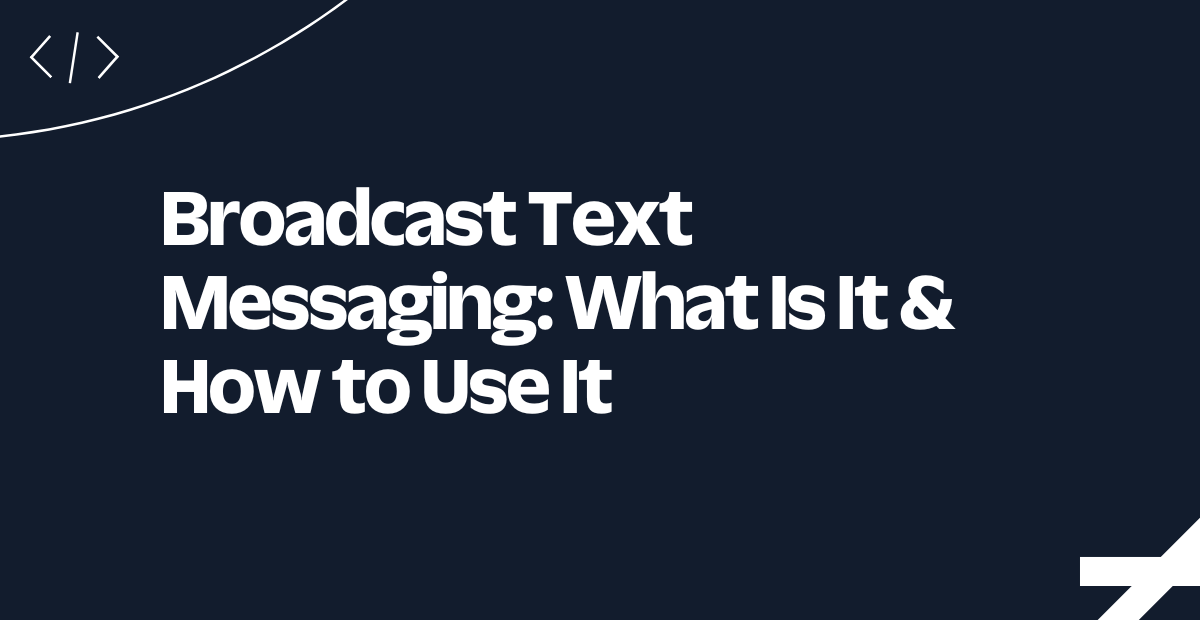Broadcast Text Messaging: What Is It & How to Use It
Time to read:

With the rise of smartphones, communication has become more accessible than ever—giving companies an advantage in reaching and connecting with customers. After all, what’s more effective than a platform that fits in the palm of your hand?
Broadcast messaging is one of many meaningful ways to interact with a customer base, providing efficiency, security, and deliverability. But what is a broadcast text message, who are its recipients, and why is it so effective?
Here, we’ll explore the answers and use cases for your business.
What is broadcast messaging?
Broadcast text refers to the process of sending a message to a large contact list. As long as the recipient consents to receiving a text broadcast, similar to how they would sign up for a company’s marketing newsletter, the message will end up in their inbox like any other text. A broadcast text message may also be compatible with MMS elements, allowing marketers to weave in fun, attention-grabbing elements like GIFs or images.
MMS group vs. broadcast message
What is the difference between broadcast vs. MMS? At first glance, it’s easy to identify their similarities. After all, MMS and broadcast texts both allow senders to deliver a message to multiple recipients.
In MMS threads, every person in the group can respond to the original sender, creating long text message chains that everyone can see. On the other hand, in a text message broadcast, recipients can respond to the sender privately—without seeing group information or interacting with one another. With broadcast messaging, you can ensure that your customers’ personal data, like locations and phone numbers, remains fully protected.
A broadcast text message also helps businesses maximize reach while ensuring high deliverability rates. While MMS has a limit to its recipient quantity, broadcast messages can reach an unlimited number of people, allowing you to send messages in bulk.
How does broadcast messaging work?
Broadcast messaging follows a relatively simple process:
- The user establishes a contact list to determine who will receive their messages.
- The user then chooses a business messaging platform that will help deliver their message to the intended recipients. (Using a reliable messaging service is crucial, especially if a company is sending out a bulk text message—or if the user wants to segment different messages to subscribers.)
- The user drafts their message, including visual elements wherever necessary.
- The user schedules or sends the message.
How can businesses use broadcast text messaging?
Organizations might use business broadcast messaging for the following:
- A new and exclusive product promotion for subscribers
- An important status report during a natural disaster
- A campus-wide update for university students
- An out-of-office text alert for company employees
- A scheduled change for a doctor’s appointment
Essentially, businesses rely on a text message broadcast to connect with customers across multiple channels and boost engagement. Whether providing customer service or engaging with marketing, broadcast messaging builds the key digital relationships that contribute to higher customer satisfaction, according to common use cases.
Reminder alerts
Reminder alerts notify customers of an upcoming appointment, event, or product promotion. This type of broadcast keeps them in the loop, inviting response and strengthening connection with your business.
These alerts can also save you time and resources, especially if you’re a retailer, medical clinic, restaurant, or any business that involves booking appointments.
Feedback requests
Feedback requests are always valuable for businesses, as these allow you to identify problems and implement changes. While sending a feedback survey through email can be effective, an SMS survey might garner higher engagement—especially since SMS has a 98% open rate.
Plus, customers are likely to take notice when you tailor your services to meet their needs and expectations. The payoff will be well worth your effort.
Customer service updates
Customer service updates keep consumers informed, with quick, efficient communication and high visibility being critical. With frequent updates, you can assure your customers you’re working to finding solutions from the start of their journey to actual completion.
Most customer service broadcasts pertain to orders received and shipped, but these can also remind shoppers of abandoned shopping carts and thank them for their purchases. Short and simple, broadcast texts show customers they’re valued.
Send messages to bulk audiences with Twilio
Broadcast messaging is a powerful way to connect with every customer through the comfort of their mobile devices and a few by opt-in channels. Plus, with many use cases and a simple integration process, you can strengthen your digital relationships and demonstrate your ability to meet customers where they are with broadcast messaging through the Twilio SMS API.
Twilio's SMS API, coupled with the message scheduling feature, helps you reach your audience—no matter the size—and manage opt-ins by channel. This enables businesses to send bulk messages with simple, powerful solutions that ensure security and reliability.
Want to learn more about the benefits and implementation of broadcast messaging for your business strategy? Contact Twilio today to get started.
Related Posts
Related Resources
Twilio Docs
From APIs to SDKs to sample apps
API reference documentation, SDKs, helper libraries, quickstarts, and tutorials for your language and platform.
Resource Center
The latest ebooks, industry reports, and webinars
Learn from customer engagement experts to improve your own communication.
Ahoy
Twilio's developer community hub
Best practices, code samples, and inspiration to build communications and digital engagement experiences.


